ICOM (A0) Diagram
Innoslate's ICOM (Inputs, Controls, Outputs, and Mechanisms) Diagram is a structure diagram showing relationships between Inputs/Outputs, Actions, and Assets.
Using ICOM Diagrams
| Function | Description |
|---|---|
| Creating ICOM Diagrams | Using ‘Diagrams View’ in Innoslate, you can create a new ‘ICOM Diagram’. |
| Viewing ICOM Diagrams | The ‘ICOM Diagram’ supports two unique diagram constructs: an ‘Input/Output/Control (Input/Output),’ and a ‘Mechanism (Asset) |
| ICOM Diagram Constructs | The ‘ICOM Diagram’ supports two unique diagram constructs: an ‘Input/Output/Control (Input/Output),’ and a ‘Mechanism (Asset). |
| Adding a Construct | A construct can be added to an ‘ICOM Diagram’ via drag-and-drop. |
| Removing a Construct | A construct can be easily removed from an ‘ICOM Diagram.’ |
The ‘ICOM (Inputs, Controls, Outputs, and Mechanisms) Diagram’ is a structure diagram showing relationships between Inputs/Outputs, Actions, and Assets. The different ICOM arrows are identified by the side of the activity box which they touch. Thus inputs are on the left, controls are at the top, outputs are on the right, and mechanisms are at the bottom.

Creating ICOM Diagrams
Within the ‘Diagrams Dashboard,’ users can create a new diagram by clicking the ‘ Create Diagram’ button in the top right corner of the page.

Clicking the ‘Create Diagram’ button will open the Create Diagram dialog where you will be directed through the process of creating a new diagram.
Create an ICOM Diagram
- Choose Which Type of Diagram to Create
In step 1, select ‘ICOM Diagram,’ under ‘General,’ as your diagram type.
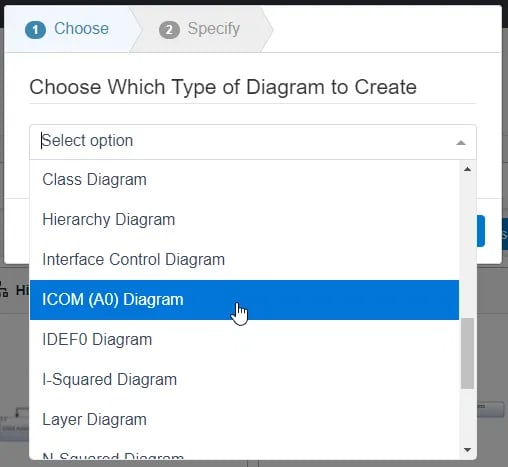
Click the ‘Next’ button.
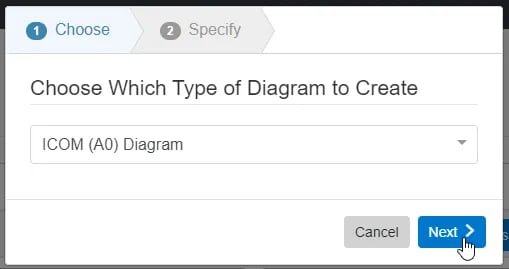
- Specify New Root Action Information
In step 2, you will be prompted to input a diagram ‘Name,’ ‘Number’ (optional), and ‘Description’ (optional). Then, click the ‘Finish’ button to save and automatically open your new ICOM Diagram.
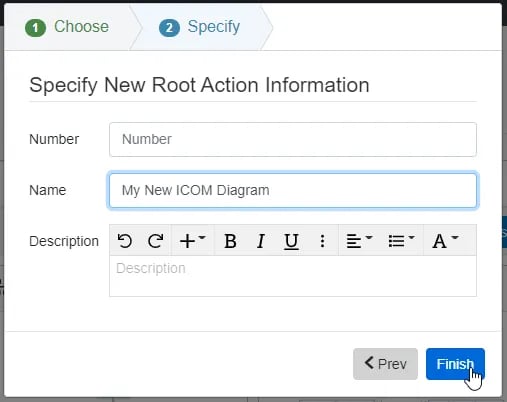
- Note, the Root Action construct created in step 2 will appear on the canvas.
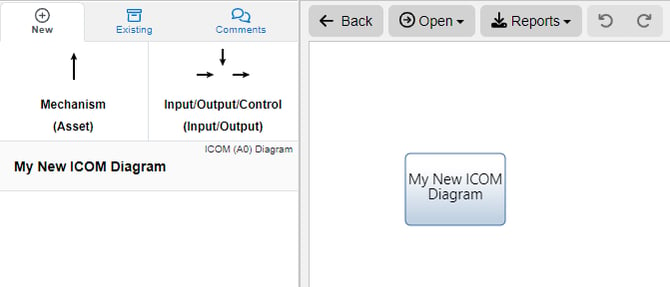
Viewing ICOM Diagrams
In Innoslate, you can view an ‘ICOM Diagram’ from wherever the ‘Open’ drop-down menu is available on the toolbar (Entity View, Database View, within a Diagram).
View an ICOM Diagram

- Locate and click the ‘Open’ drop-down menu in the toolbar. Select ‘ICOM Diagram.’
- This will navigate you to view an ‘ICOM Diagram,’ where you can begin adding and removing entities. Click the ‘Save’ button located on the toolbar to persist your changes to your project’s database.
ICOM Diagram Constructs
The ‘ICOM Diagram’ supports four unique diagram constructs: a ‘Mechanism,’ an ‘Input,’ an ‘Output,’ and a ‘Control.’
-
Mechanism
This construct is used to capture the physical means of performing a system function.
In the system model, an Asset entity is used to represent a ‘Mechanism’ construct with a 'performs' relationship to the entity which represents the ‘Function’ construct being pointed to. By default, Innoslate’s database schema includes labels to specify the type of this Asset entity as a(n) Architecture, Context, Environment, External System, Facility, Infrastructure, Materiale, Organization, Package, Personnel, Segment, Service, Subsystem, and/or System.
In the diagram, this construct is represented as an arrow (directed line) that points up to the bottom of a ‘Function’ construct.
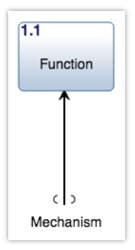
-
Input
This construct is used to capture anything introduced into the system being modeled.
In the system model, an Input/Output entity is used to represent an ‘Input’ construct with a received by relationship to the entity which represents the ‘Function’ construct being pointed to. By default, Innoslate’s database schema includes labels to specify the type of this Input/Output entity as Analog, Digital, Event, Mixed, Physical, Product, Response, and/or Verbal.
In the diagram, this construct is represented as an arrow (directed line) that points toward a ‘Function’ construct from the left.
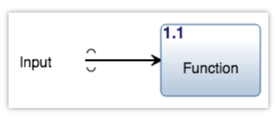
-
Output
This construct is used to capture anything produced by the system being modeled.
In the system model, an Input/Output entity is used to represent an ‘Output’ construct with a generated by relationship to the entity which represents the ‘Function’ construct being pointed away from. By default, Innoslate’s database schema includes labels to specify the type of this Input/Output entity as Analog, Digital, Event, Mixed, Physical, Product, Response, and/or Verbal.
In the diagram, this construct is represented as an arrow (directed line) that points away from the right of a ‘Function’ construct.
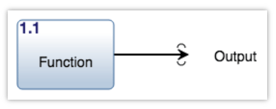
-
Control
This construct is used to capture system components that regulate the behavior of other system components.
In the system model, an Input/Output entity is used to represent a ‘Control’ construct with a received by relationship to the entity which represents the ‘Function’ construct being pointed to. By default, Innoslate’s database schema includes labels to specify the type of this Input/Output entity as Analog, Digital, Event, Mixed, Physical, Product, Response, and/or Verbal.
In the diagram, this construct is represented as an arrow (directed line) that points down to the top of a ‘Function’ construct.
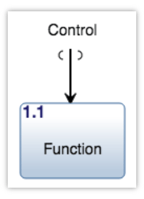
Adding a Construct

An entity can be added to an ‘ICOM Diagram’ via drag-and-drop. The Root Entity created from the Create Diagram dialog will already appear as a Function Entity
- Within an ‘ICOM Diagram,’ ensure you do not currently have an Input/Output/Control or Mechanism selected, and click the corresponding icon in the ‘New’ tab of the left sidebar and continue to hold down the left mouse button.
- Drag the entity over to the adjacent diagram canvas, if selecting the Input/Output/Control construct, note the Funtion Entity will change to allows you to choose the proper construct.

- Release the left mouse button while over the diagram canvas. Notice the entity stays selected once it has been dropped. Since it is selected, the toolbar changes to include buttons for functions that can be used on the construct. The sidebar also changes to show the ‘Metadata,’ ‘Attributes’ and ‘Relationships’ tabs.

- Enter a meaningful ‘Name’ for your new entity via the ‘Attributes’ tab of the left sidebar (focused automatically for convenience).

- Click the ‘Save’ button located on the toolbar to persist your changes to your project’s database.

Note: The above process describes using the ‘New’ tab of the left sidebar, which automatically generates a new entity to represent each new block. If you would like to reuse existing entities from your database in your diagram, use the ‘Existing’ tab instead.
Removing a Construct
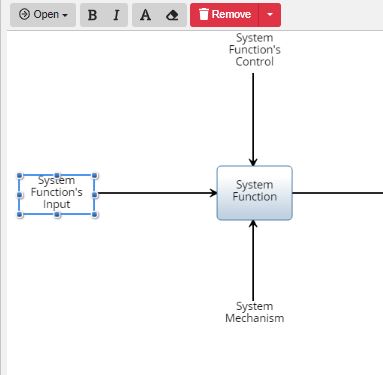
A construct can be easily removed from an ‘ICOM Diagram.’
- Within an ‘ICOM Diagram,’ select the entity you wish to remove. This will make the toolbar appear with applicable functions which can be used on the selected entity.
- Click the ‘Remove’ button to remove the entity from the diagram (as the default action).
Note, The ‘Remove’ button also includes a drop-down menu where you can select ‘Delete from Database’ or the default option of ‘Remove from Diagram.’

To continue learning about General Diagrams, Click Here.
(Next Article: ICOM (A0) Modifications & Settings)
